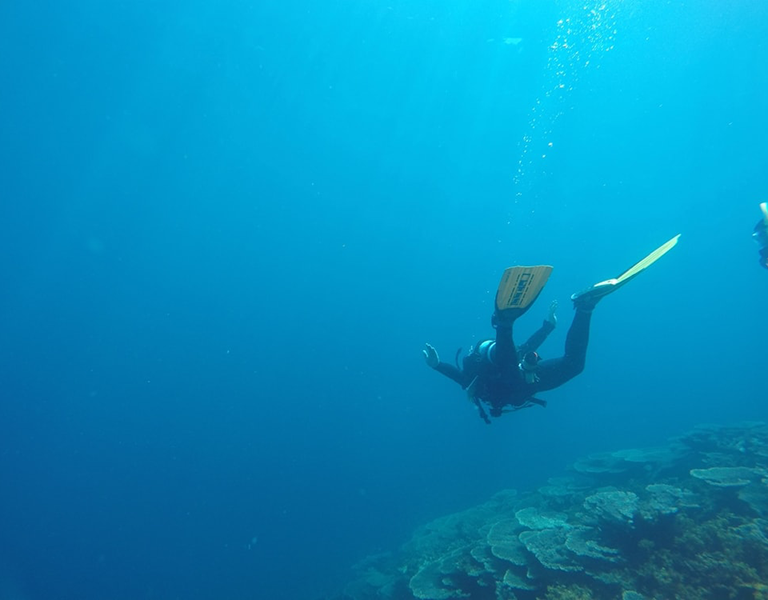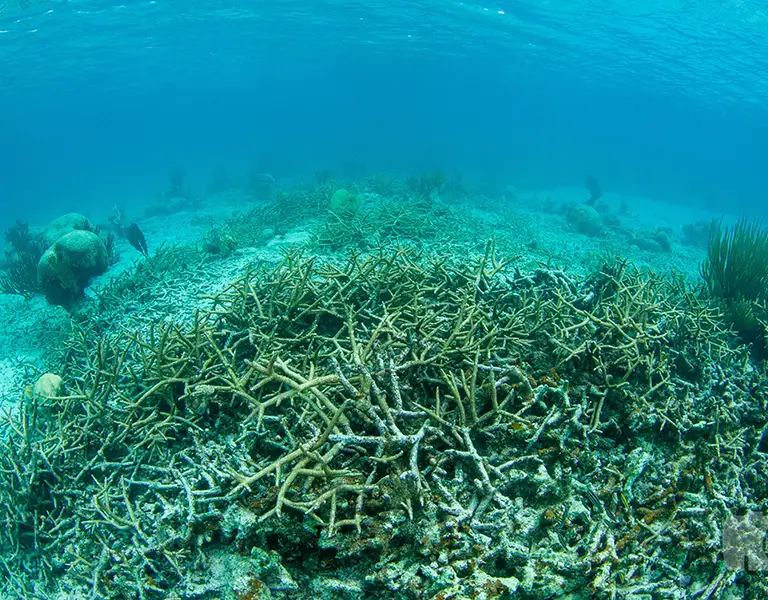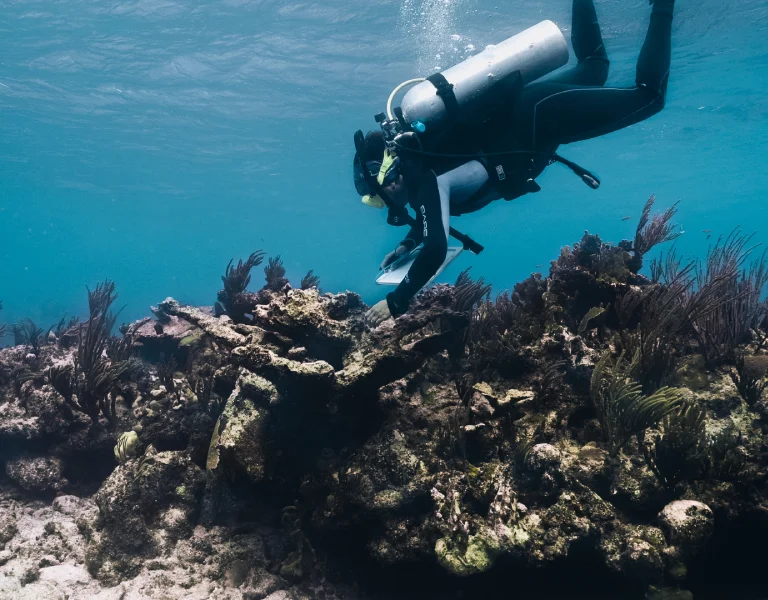Key Takeaways
- The Great Barrier Reef experienced its fifth mass bleaching event in 2024, affecting 74% of surveyed reefs with unprecedented spatial extent across all regions
- Rising ocean temperatures from climate change are the primary driver of coral bleaching, with the 2024 event causing coral cover to drop by up to 30% in some regions
- Mass bleaching events have accelerated dramatically, occurring six times since 2016 compared to just twice in the previous two decades
- Coral restoration through land-based farming and assisted evolution techniques offers a meaningful pathway to help reefs recover and build resilience
- Protecting coral reefs requires both immediate local conservation action and urgent global emissions reductions to address the root cause of ocean warming
The Great Barrier Reef stands as one of Earth’s most extraordinary natural wonders. Stretching over 2,300 kilometers along Australia’s northeastern coast, this living masterpiece harbors an astonishing diversity of life, from 400 species of coral to 1,500 species of fish, sea turtles, dolphins, and countless other marine creatures.1 Yet this underwater realm faces an existential threat that’s accelerating faster than many scientists predicted: coral bleaching driven by rapidly warming ocean temperatures.
What Is Coral Bleaching?
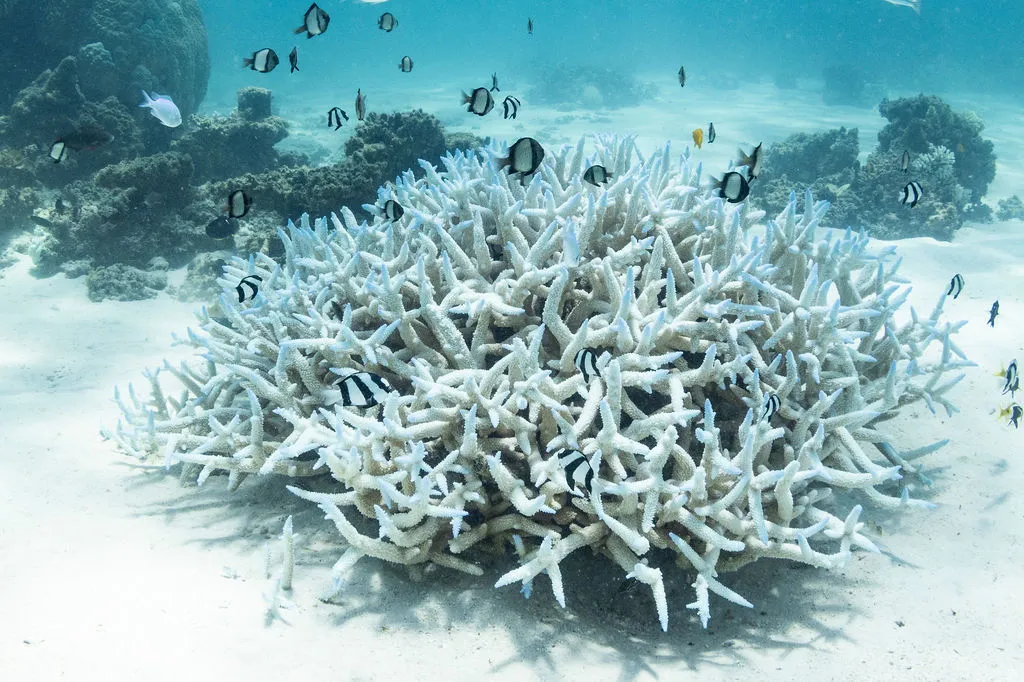
To understand the crisis unfolding beneath the waves, it helps to know what makes coral reefs so vibrant in the first place. Coral polyps (the tiny animals that form reef structures) live in symbiosis with microscopic algae called zooxanthellae. These algae provide corals with food through photosynthesis while giving reefs their brilliant colors.
When ocean temperatures rise even one degree Celsius above normal for just four weeks, corals experience heat stress.2 In response, they expel the zooxanthellae living in their tissues. Without these vital partners, corals lose their color and turn ghostly white, hence the term “bleaching.” While bleached corals aren’t immediately dead, they’re starving and far more vulnerable to disease and mortality. If temperatures don’t return to normal soon enough, the corals die, leaving behind skeletal remains where thriving ecosystems once flourished.
The Unprecedented 2024 Bleaching Event
The Great Barrier Reef has experienced mass coral bleaching events in 1998, 2002, 2016, 2017, 2020, 2022, and 2024, with seven events occurring in less than three decades, six of them since 2016.3 The 2024 event marked a grim milestone as the most spatially extensive bleaching ever recorded on the reef.
Aerial surveys conducted across 1,080 reefs in March 2024 revealed bleaching affecting 74% of surveyed areas across all three regions: northern, central, and southern.4 Some reefs experienced severe bleaching affecting over 60% of their coral cover. The southern Great Barrier Reef, which had largely escaped previous mass bleaching events, was hit particularly hard. At One Tree Reef, scientists tracking 462 individual coral colonies found that 80% had bleached by April 2024, and by July, 44% of bleached colonies had died.5
The fast-growing Acropora corals (the architectural engineers that build reef structures and had driven recovery between 2017 and 2024) suffered devastating 95% mortality rates at some sites.6 Even the protected status and offshore location of these reefs couldn’t shield them from the extreme heat stress.
The Global Context: A Planetary Emergency
The Great Barrier Reef isn’t suffering alone. The 2024 event formed part of the fourth global coral bleaching event, which began in February 2023 and represents the most extensive coral crisis in recorded history. From January 2023 through March 2025, bleaching-level heat stress impacted 84% of the world’s coral reef areas across 82 countries and territories.7
This staggering figure dwarfs previous global events. The 1998 event affected 21% of reefs, 2010 impacted 37%, and the 2014-2017 event reached 68%.8 The scale of destruction became so severe that NOAA’s Coral Reef Watch program had to add three new alert levels to their bleaching scale, acknowledging that some reefs now face risks of over 80% coral mortality from prolonged heat stress.9
Why This Matters Beyond the Reef
When coral reefs bleach and die, the consequences ripple far beyond the underwater landscape. Approximately one-third of all known marine species depend on coral reefs at some point in their lives, despite reefs covering less than 1% of the ocean floor.10 As reefs degrade, fish populations decline, disrupting marine food webs and the fishing communities that depend on them.
The economic implications are profound. Coral reefs provide an estimated $10 trillion in global benefits annually through fisheries, tourism, coastal protection, and pharmaceutical discoveries.11 For coastal communities, particularly in developing nations, healthy reefs serve as natural barriers that dissipate wave energy and protect shorelines from storms and erosion. When reefs crumble, these communities become more vulnerable to coastal flooding and economic hardship.
One billion people worldwide benefit from coral reefs either directly or indirectly.12 For many island nations and coastal regions, reef tourism represents a primary economic driver. The Great Barrier Reef alone contributes billions to Australia’s economy and supports tens of thousands of jobs.
The Root Cause: Climate Change and Ocean Warming
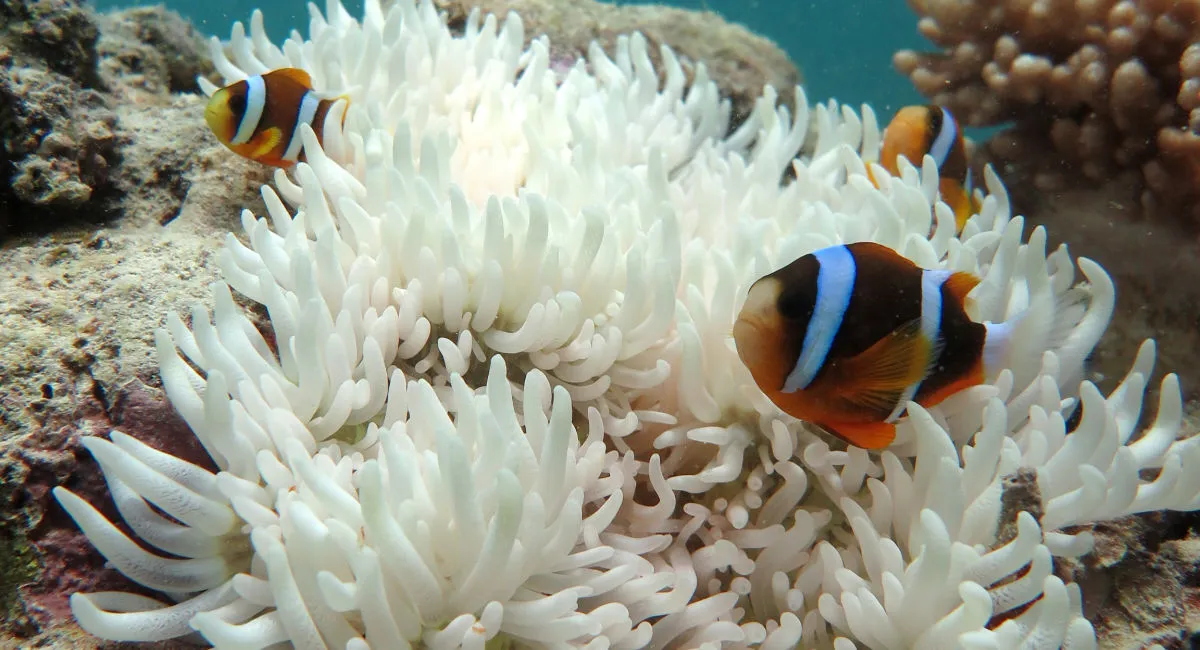
The overwhelming scientific consensus points to one primary driver of mass coral bleaching: rising ocean temperatures caused by climate change. The world’s oceans have absorbed approximately 93% of the excess heat trapped in Earth’s atmosphere by greenhouse gas emissions.13 This thermal load has pushed 2024 ocean temperatures to record highs, surpassing even the unprecedented warmth of 2023.
The 2024 Great Barrier Reef bleaching occurred during conditions that brought multiple stressors including cyclones, flooding, and crown-of-thorns starfish outbreaks, but the mass bleaching event proved to be the primary source of coral mortality.14 Heat stress in the southern Great Barrier Reef peaked at 2.3-2.5°C above historical summer maxima, with some inshore reefs experiencing 12.0-15.5 degree heating weeks, the highest levels ever recorded by satellite monitoring.15
What makes this trajectory particularly alarming is the accelerating frequency of bleaching events. The average interval between mass bleaching events on the Great Barrier Reef has been cut in half since 1980.16 Coral reefs need years, sometimes decades, to fully recover from severe bleaching. With events now occurring years or even months apart, recovery windows are closing. The Great Barrier Reef experienced back-to-back bleaching in 2016-2017 and again in 2024-2025, the second time in its history that consecutive years brought mass bleaching stress.17
Can Corals Recover?
Despite the sobering statistics, bleached coral isn’t dead coral. If ocean temperatures stabilize and return to normal ranges quickly enough, corals can take back their symbiotic algae and recover their health. After the 2024 bleaching peak in the Great Barrier Reef, approximately 16% of tracked coral colonies showed recovery by July, demonstrating that resilience is possible under the right conditions.18
However, recovery becomes increasingly difficult with each successive bleaching event, especially when corals don’t receive adequate time to rebuild their energy reserves and structural integrity between stressors. Fast-growing branching corals like Acropora, which can rapidly colonize damaged reefs, are often the most vulnerable to heat stress. Their loss removes the species best positioned to drive quick recovery, potentially shifting reef communities toward slower-growing, more heat-tolerant species and fundamentally changing reef ecosystems.
Restoration as Part of the Solution
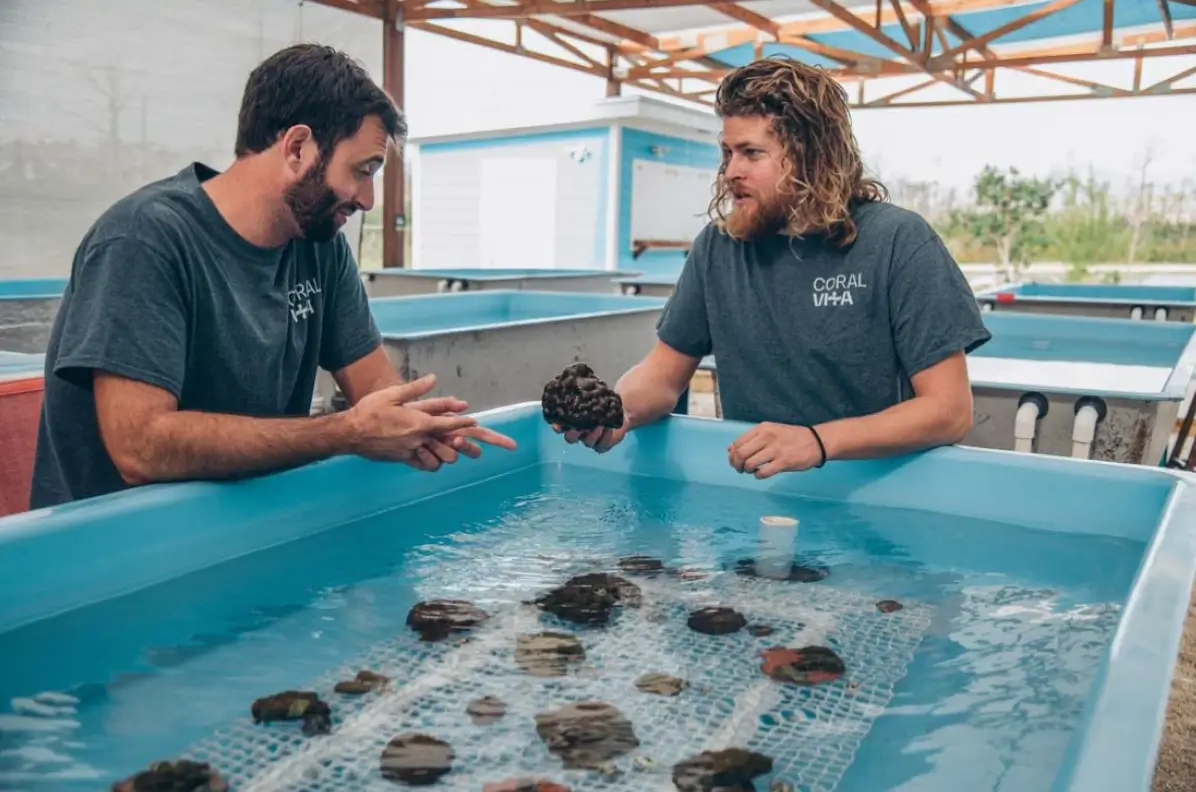
In the face of this crisis, coral restoration has emerged as a crucial tool within a broader conservation strategy. Organizations working at the forefront of reef recovery are demonstrating that intentional, science-based restoration can help damaged reefs rebuild while buying time for larger climate solutions to take effect.
The regenerative blue economy, which encompasses sustainable ocean-based industries and conservation efforts, recognizes that protecting and restoring marine ecosystems creates value for both nature and coastal communities. Coral restoration sits at the intersection of marine conservation, climate adaptation, and economic opportunity.
Modern coral farming techniques allow restoration practitioners to grow diverse coral species in land-based facilities in months rather than the decades required in nature. These farms create controlled environments where corals can be raised from fragments or spawned larvae, then strengthened against environmental stressors before being transplanted back to degraded reefs.
What sets cutting-edge restoration apart is the integration of assisted evolution, scientific techniques that enhance coral resilience to warming waters. By exposing corals to gradually increasing temperatures in controlled settings or selecting naturally heat-tolerant genotypes, restoration efforts can help reefs develop greater capacity to withstand future bleaching events. This work doesn’t replace the urgent need to reduce greenhouse gas emissions, but it offers a meaningful way to preserve biodiversity and maintain reef functionality while humanity addresses the root causes of climate change.
Effective coral restoration must be community-centered, ensuring that local populations who depend on reefs for food, income, and coastal protection remain integral to conservation efforts. This means creating educational opportunities, sustainable livelihoods, and long-term stewardship programs that empower frontline communities as reef guardians.
What Needs to Happen Now
Protecting the Great Barrier Reef and coral reefs worldwide requires action on multiple fronts. Most critically, reducing greenhouse gas emissions must become an urgent global priority. As long as oceans continue warming, coral reefs will face existential threat regardless of local conservation measures.
At regional and local levels, reducing stressors that compound climate impacts (pollution, overfishing, coastal development, and agricultural runoff) gives reefs better odds of surviving heat stress. Well-managed marine protected areas, improved water quality, and sustainable fishing practices all contribute to reef resilience.
Investing in coral restoration and reef monitoring provides both immediate and long-term benefits. Restoration can accelerate recovery on degraded reefs, maintain genetic diversity, and test innovative approaches to building climate-adapted coral populations. Comprehensive monitoring programs track reef health changes, identify areas needing intervention, and help scientists understand which corals and locations show greatest resilience, knowledge that informs both conservation priorities and restoration strategies.
Finally, education and awareness matter profoundly. The more people understand what coral reefs provide and why they’re threatened, the more support builds for protecting them. Every conversation about reef bleaching, every adoption of ocean-friendly practices, and every advocacy effort for climate action contributes to the collective will needed to preserve these ecosystems.
Looking Forward with Realistic Hope
The science is clear and sobering: coral reefs face immense challenges, and the window for preventing catastrophic losses is narrowing. Climate predictions suggest that without dramatic emissions reductions, mass coral bleaching could occur annually on most reefs by 2050.19 The Great Barrier Reef’s recent experiences demonstrate that even the most iconic and protected reefs aren’t immune to global warming’s impacts.
Yet giving up isn’t an option. Coral reefs have survived for millions of years, adapting through major environmental changes. They possess remarkable resilience when given the opportunity to recover. More importantly, the human communities and countless species that depend on reefs deserve every effort to preserve these ecosystems.
The path forward requires both urgency and persistence, acknowledging the severity of the crisis while refusing to accept reef loss as inevitable. It means supporting climate policies that rapidly reduce emissions while simultaneously investing in reef restoration, protection, and community resilience. It means recognizing that solutions need to operate across scales, from global agreements to local stewardship.
The Great Barrier Reef bleaching crisis isn’t just an environmental story. It’s a clarion call for how humanity responds to interconnected challenges of climate change, biodiversity loss, and environmental justice. The corals themselves can’t advocate for their survival. That responsibility falls to us, and the time to answer that call is now.
About Coral Vita
Coral Vita is a mission-driven company dedicated to restoring our world’s dying and damaged reefs. Using innovative land-based farming techniques, Coral Vita grows diverse and resilient corals in months instead of the decades they take in nature. These corals are then transplanted into threatened reefs, helping to preserve ocean biodiversity while protecting coastal communities that depend on healthy reefs for protection, food, and income.
Founded by environmental entrepreneurs Sam Teicher and Gator Halpern, Coral Vita’s high-tech coral farms incorporate breakthrough methods to restore reefs in the most effective way possible. In 2021, the company was recognized as the inaugural winner of Prince William’s Revive Our Oceans Earthshot Prize Winner for their pioneering work in coral restoration.
To learn more about Coral Vita’s work or to get involved in coral reef conservation efforts, visit their website at www.coralvita.co or contact them directly through their Contact Us page.
Frequently Asked Questions
What causes coral bleaching on the Great Barrier Reef?
Coral bleaching occurs primarily when ocean temperatures rise above normal levels due to climate change. When water becomes too warm, corals expel the symbiotic algae that provide them with food and color, causing them to turn white and become vulnerable to starvation and disease.
How often does the Great Barrier Reef experience bleaching events?
The frequency has accelerated dramatically. While mass bleaching events were rare before the 1980s, the Great Barrier Reef has now experienced seven mass bleaching events since 1998, with six occurring just since 2016, demonstrating a concerning trend toward more frequent events.
Can bleached coral recover?
Yes, if temperatures stabilize quickly, bleached corals can recover by taking back their symbiotic algae. However, recovery requires time without additional stressors, and successive bleaching events with short intervals make full recovery increasingly difficult. Many severely bleached corals die before temperatures normalize.
What can be done to help the Great Barrier Reef?
Protecting the reef requires addressing climate change through emissions reductions while implementing local conservation measures including water quality improvement, sustainable fishing practices, marine protected areas, and science-based coral restoration. Supporting organizations working on reef conservation and advocating for climate policies also help create systemic change.
References
- https://www.aljazeera.com/news/2025/8/6/australias-great-barrier-reef-hit-by-record-bleaching-as-oceans-warm ↩︎
- https://www.barrierreef.org/the-reef/threats/coral-bleaching ↩︎
- https://www.aims.gov.au/research-topics/environmental-issues/coral-bleaching/coral-bleaching-events ↩︎
- https://www.aims.gov.au/sites/default/files/2024-04/FINAL-Aerial%20Bleaching%20GBR2024Report_AIMS_Final_15Apr2024.pdf ↩︎
- https://aslopubs.onlinelibrary.wiley.com/doi/10.1002/lol2.10456 ↩︎
- https://www.aims.gov.au/monitoring-great-barrier-reef/gbr-condition-summary-2024-25 ↩︎
- https://icriforum.org/4gbe-2025/ ↩︎
- https://icriforum.org/4gbe-2025/ ↩︎
- https://en.wikipedia.org/wiki/2023–2025_global_coral_bleaching_event ↩︎
- https://www.unep.org/news-and-stories/story/worlds-corals-are-bleaching-heres-why-and-what-it-means-oceans-future ↩︎
- https://icriforum.org/4gbe-2025/ ↩︎
- https://icriforum.org/4gbe-2025/ ↩︎
- https://www.aljazeera.com/news/2025/8/6/australias-great-barrier-reef-hit-by-record-bleaching-as-oceans-warm ↩︎
- https://www.aims.gov.au/monitoring-great-barrier-reef/gbr-condition-summary-2024-25 ↩︎
- https://www.aims.gov.au/sites/default/files/2024-04/FINAL-Aerial%20Bleaching%20GBR2024Report_AIMS_Final_15Apr2024.pdf ↩︎
- https://en.wikipedia.org/wiki/Coral_bleaching ↩︎
- https://www.aims.gov.au/research-topics/environmental-issues/coral-bleaching/coral-bleaching-events ↩︎
- https://aslopubs.onlinelibrary.wiley.com/doi/10.1002/lol2.10456 ↩︎
- https://coralreefwatch.noaa.gov/satellite/research/coral_bleaching_report.php ↩︎



